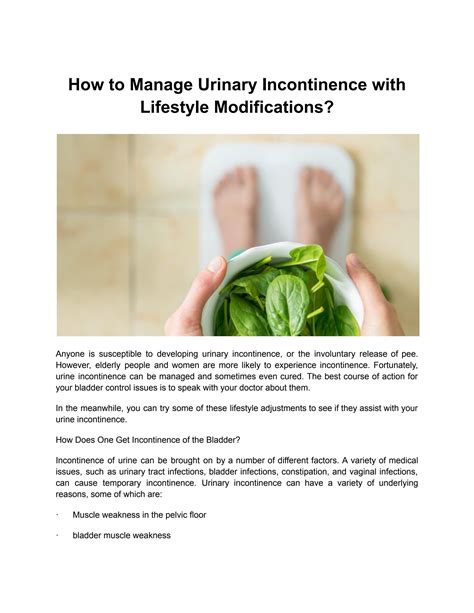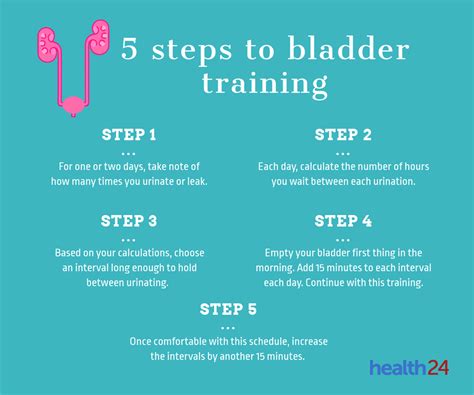Intro
Discover 5 effective ways to treat urge incontinence, including bladder training, pelvic exercises, and lifestyle changes, to manage overactive bladder symptoms and regain control with incontinence treatment options.
Urge incontinence, also known as overactive bladder, is a condition where a person experiences a sudden, intense need to urinate, often resulting in involuntary loss of urine. This condition can be embarrassing, disrupt daily activities, and affect a person's quality of life. Understanding the importance of managing urge incontinence is crucial for individuals suffering from this condition. It's essential to recognize the symptoms, causes, and treatment options available to effectively manage urge incontinence.
The prevalence of urge incontinence is significant, affecting millions of people worldwide. Women are more likely to experience urge incontinence, especially during menopause or after childbirth. However, men can also develop this condition, often due to prostate issues or neurological disorders. The impact of urge incontinence on daily life can be substantial, causing anxiety, depression, and social isolation. Therefore, it's vital to address this condition and explore treatment options to improve overall well-being.
Managing urge incontinence requires a comprehensive approach, incorporating lifestyle modifications, behavioral therapies, and medical interventions. By understanding the underlying causes and symptoms of urge incontinence, individuals can take the first step towards effective management. This article will delve into the various treatment options, including lifestyle changes, pelvic floor exercises, bladder training, medication, and surgical interventions. By exploring these alternatives, individuals can find the most suitable approach to alleviate symptoms and regain control over their bladder.
Understanding Urge Incontinence

Causes and Risk Factors
The causes and risk factors associated with urge incontinence are diverse and multifaceted. Some of the most common causes include: * Neurological disorders, such as multiple sclerosis or Parkinson's disease * Bladder problems, such as bladder infections or bladder stones * Hormonal changes, such as menopause or pregnancy * Certain medications, such as diuretics or sedatives * Age, with older adults being more susceptible to urge incontinence * Obesity, which can put additional pressure on the bladderLifestyle Modifications for Urge Incontinence

Pelvic Floor Exercises
Pelvic floor exercises, also known as Kegel exercises, are a highly effective way to strengthen the muscles that support the bladder and urethra. These exercises involve contracting and releasing the pelvic floor muscles to improve bladder control and reduce symptoms of urge incontinence. To perform Kegel exercises: 1. Identify the pelvic floor muscles by stopping the flow of urine mid-stream 2. Contract the pelvic floor muscles for 5-10 seconds 3. Release the muscles for 5-10 seconds 4. Repeat the exercise 10-15 times, 3-4 times a dayBladder Training for Urge Incontinence

Medications for Urge Incontinence
Medications can be an effective way to manage symptoms of urge incontinence. Some common medications used to treat urge incontinence include: * Anticholinergics, which help relax the bladder muscles * Beta-3 adrenergic agonists, which help improve bladder capacity * Topical estrogen, which can help improve bladder control in postmenopausal women It's essential to consult with a healthcare provider to determine the best course of treatment and to discuss potential side effects.Surgical Interventions for Urge Incontinence

Alternative Therapies
Alternative therapies, such as acupuncture and biofeedback, may also be effective in managing symptoms of urge incontinence. These therapies can help: * Improve bladder control * Reduce symptoms of urge incontinence * Enhance overall well-being It's essential to consult with a healthcare provider to discuss the potential benefits and risks of alternative therapies.What is the most effective way to manage urge incontinence?
+The most effective way to manage urge incontinence is through a combination of lifestyle modifications, behavioral therapies, and medical interventions. It's essential to work with a healthcare provider to develop a personalized treatment plan.
Can pelvic floor exercises cure urge incontinence?
+Pelvic floor exercises can significantly improve bladder control and reduce symptoms of urge incontinence. However, they may not completely cure the condition. It's essential to combine pelvic floor exercises with other treatment options for optimal results.
Are there any risks associated with surgical interventions for urge incontinence?
+Yes, there are risks associated with surgical interventions for urge incontinence, including infection, bleeding, and scarring. It's essential to discuss the potential risks and benefits with a healthcare provider before undergoing surgery.
In conclusion, managing urge incontinence requires a comprehensive approach that incorporates lifestyle modifications, behavioral therapies, and medical interventions. By understanding the underlying causes and symptoms of urge incontinence, individuals can take the first step towards effective management. It's essential to work with a healthcare provider to develop a personalized treatment plan and to explore alternative therapies to enhance overall well-being. We invite you to share your experiences and ask questions in the comments section below. Additionally, please share this article with anyone who may be struggling with urge incontinence, and let's work together to raise awareness and promote effective management of this condition.
